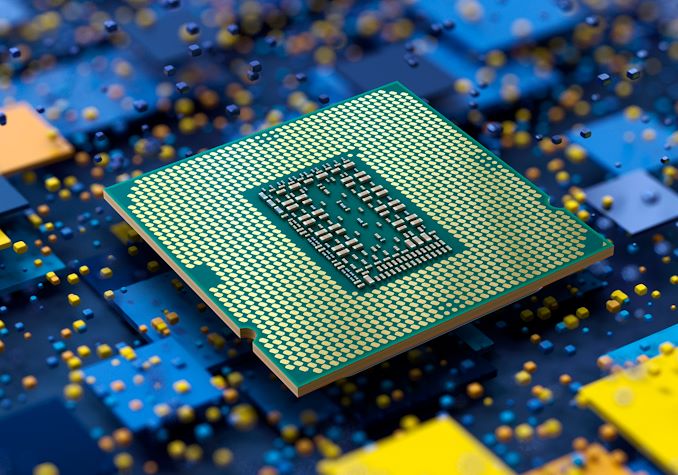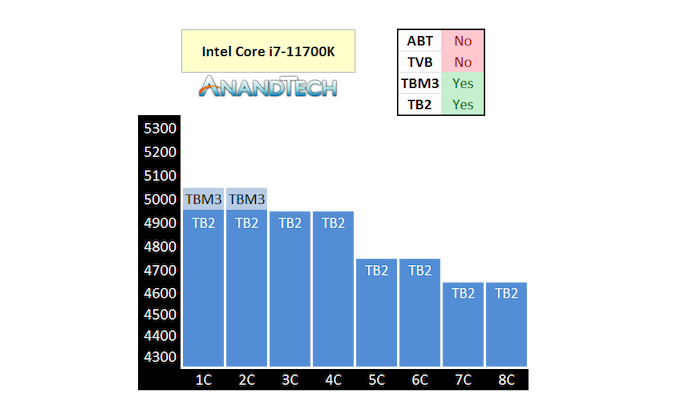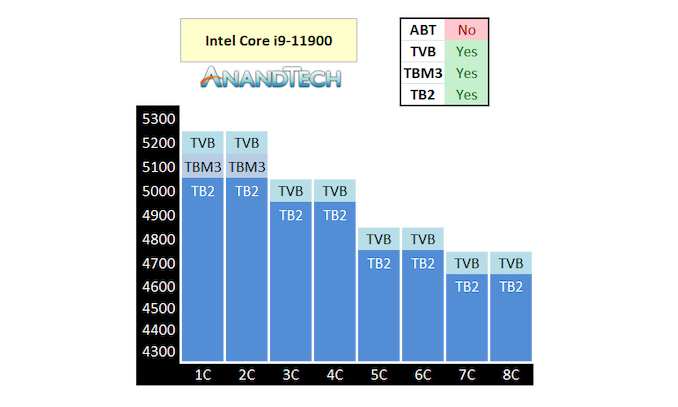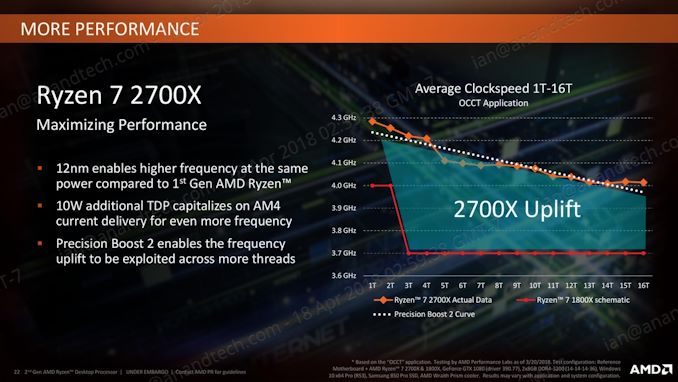Intel’s New Adaptive Boost Technology: Floating Turbo Comes to Rocket Lake
by Dr. Ian Cutress on March 19, 2021 9:00 AM EST
A couple of days after Intel officially announced its 11th Generation Core Rocket Lake, the press received an email about a new feature coming to the platform that wasn’t in our original briefing. The goal of this feature is to provide more performance to users that have good processors, and Intel is calling it Adaptive Boost Technology.
Adaptive Boost Technology is now the fifth frequency metric Intel uses on its high-end enthusiast grade processors, and another element in Intel’s ever complex ‘Turbo’ family of features. Here’s the list, in case we forget one:
| Intel Frequency Levels | ||
| Base Frequency | - | The frequency at which the processor is guaranteed to run under warranty conditions with a power consumption no higher than the TDP rating of the processor. |
| Turbo Boost 2.0 | TB2 | When in a turbo mode, this is the defined frequency the cores will run at. TB2 varies with how many cores are being used. |
| Turbo Boost Max 3.0 | TBM3 'Favored Core' |
When in a turbo mode, for the best cores on the processor (usually one or two), these will get extra frequency when they are the only cores in use. |
| Thermally Velocity Boost | TVB | When in a turbo mode, if the peak thermal temperature detected on the processor is below a given value (70ºC on desktops), then the whole processor will get a frequency boost of +100 MHz. This follows the TB2 frequency tables depending on core loading. |
| Adaptive Boost Technology | ABT 'floating turbo' |
When in a turbo mode, if 3 or more cores are active, the processor will attempt to provide the best frequency within the power budget, regardless of the TB2 frequency table. The limit of this frequency is given by TB2 in 2-core mode. ABT overrides TVB when 3 or more cores are active. |
| *Turbo mode is limited by the turbo power level (PL2) and timing (Tau) of the system. Intel offers recommended guidelines for this, but those guidelines can be overridden (and are routinely ignored) by motherboard manufacturers. Most gaming motherboards will implement an effective ‘infinite’ turbo mode. In this mode, the peak power observed will be the PL2 value. It is worth noting that the 70ºC requirement for TVB is also often ignored, and TVB will be applied whatever the temperature. | ||
Intel provided a slide trying to describe the new ABT, however the diagram is a bit of a mess and doesn’t explain it that well. Here’s the handy AnandTech version.
First up is the Core i7-11700K that AnandTech has already reviewed. This processor has TB2, TBM3, but not TVB or ABT.
The official specifications show that when one to four cores are loaded, when in turbo mode, it will boost to 4.9 GHz. If it is under two cores, the OS will shift the threads onto the favored cores and Turbo Boost Max 3.0 will kick in for 5.0 GHz. More than four core loading will be distributed as above.
On the Core i9-11900, the non-overclocking version, we also get Thermal Velocity Boost which adds another +100 MHz onto every core max turbo, but only if the processor is below 70ºC.
We can see here that the first two cores get both TBM3 (favored core) as well as TVB, which makes those two cores give a bigger jump. In this case, if all eight cores are loaded, the turbo is 4.6 GHz, unless the CPU is under 70ºC, then we get an all-core turbo of 4.7 GHz.
Now move up to the Core i9-11900K or Core i9-11900KF, which are the only two processors with the new floating turbo / Adaptive Boost Technology. Everything beyond two cores changes and TVB no longer applies.
Here we see what looks like a 5.1 GHz all-core turbo, from three cores to eight cores loaded. This is +300 MHz above TVB when all eight cores are loaded. But the reason why I’m calling this a floating turbo is because it is opportunistic.
What this means is that, if all 8 cores are loaded, TB2 means that it will run at 4.7 GHz. If there is power budget and thermal budget, it will attempt 4.8 GHz. If there is more power budget and thermal budget available, it will go to 4.9 GHz, then 5.0 GHz, then 5.1 GHz. The frequency will float as long as it has enough of those budgets to play with, and it will increase/decrease as necessary. This is important as different instructions cause different amounts of power draw and such.
If this sounds familiar, you are not wrong. AMD does the same thing, and they call it Precision Boost 2, and it was introduced in April 2018 with Zen+.
AMD applies its floating turbo to all of its processors – Intel is currently limiting floating turbo to only the Core i9-K and Core i9-KF in Core 11th Gen Rocket Lake.
One of the things that we noticed with AMD however is that this floating turbo does increase power draw, especially with AVX/AVX2 workloads. Intel is likely going to see similar increases in power draw. What might be a small saving grace here is that Intel’s frequency jumps are still limited to full 100 MHz steps, whereas AMD can do it on the 25 MHz boundary. This means that Intel has to manage larger steps, and will likely only cross that boundary if it knows it can be maintained for a fixed amount of time. It will be interesting to see if Intel gives the user the ability to change those entry/exit points for Adaptive Boost Technology.
The other difference is that for now, ABT on Intel is disabled by default. Users will have to enable it in their BIOSes to take advantage. On that scale, I suspect most won't, simply because most do not enter the BIOS. Enthusiasts might, however they might also decide to overclock, which makes ABT moot. The other alternative is that motherboard vendors will enable it by default anyway, simply because Intel says it is within specfication.
The Final Word
It’s a bit odd that Intel decided to talk about this feature two days after the official Rocket Lake announcement, to the point that BIOSes enabling ABT are only being distributed now (this doesn’t affect our Core i7-11700K review). This indicates that perhaps the feature wasn’t ready in time for the announcement, or even, ready to go and Intel was still debating whether to actually make it a feature? Then again, all of the Z590 motherboards that we’ve seen seem overbuilt for this generation of processors – Z590 starts at $175, which used to be a mid-market price, so something like ABT should be ready to go. It does make me wonder if ABT is applicable for B560 motherboards, or if it will be a Z590 only feature. Intel has stated that ABT is within warranty and not considered overclocking.
There will be some users who are already familiar with Multi-Core Enhancement / Multi-Core Turbo. This is a feature from some motherboard vendors have, and often enable at default, which lets a processor reach an all-core turbo equal to the single core turbo. That is somewhat similar to ABT, but that was more of a fixed frequency, whereas ABT is a floating turbo design. That being said, some motherboard vendors might still have Multi-Core Enhancement as part of their design anyway, bypassing ABT.
Overall, it’s a performance plus. It makes sense for the users that can also manage the thermals. AMD's implementation allowed it to get additional performance when it moved to TSMC’s 7nm. I have a feeling that Intel will have to shift to a new manufacturing node to get the best out of ABT, and we might see the feature on the more mainstream CPUs.














123 Comments
View All Comments
Calin - Monday, March 22, 2021 - link
AVX512 is much more "baked in" than another two cores.I assume they got some better timings with 8 cores as compared to 10 cores (Rocket Lake suffers at least a bit in internal timings - cache accesses, memory accesses - compared to its "predecessor")
(they most certainly got lower power use and lower silicon size by using 8 instead of 10 cores, even though one core is now a small proportion of almost any processor - x64, ARM, Apple M1, Apple phone/tablet).
GeoffreyA - Monday, March 22, 2021 - link
Looks like it doesn't cost them much, at least from a silicon point of view, to put in AVX512. I could be wrong, and will research this further, but it appears that AVX512 has been implemented by combining the 256-bit FMAs from Port 0 and 5, one from each. An FMA was added to Port 5 (and a "MulHi").In short, if I got this right, it only took adding another FMA (and MulHi?); and combining both 256-bit FMAs---one from Port 0 and one from 5---creates a single AVX512 "port," or rather the high and low order bits are dispatched to 0 and 5. Doesn't seem like a big cost, silicon-wise, though in execution terms it ends up eating quite a bit of power. Perhaps that's why AMD doesn't mind adding it in Zen 4: all it would take is combining the two 256-bit ports on the FP end when AVX512 code is being executed. On the other hand, perhaps the main burden is actually the decoding of AVX512 in the front end, and that's where RKL is taking such a massive hit. I don't know.
https://www.anandtech.com/show/14514/examining-int...
https://en.wikichip.org/w/images/thumb/2/2d/sunny_...
quadibloc - Monday, March 22, 2021 - link
And I think they made a good choice. When AVX-512 is used, it almost doubles the chip's performance. Which is why I think these chips will look better compared to AMD's chips than people think at the moment. However, since you can get 16 cores from AMD, an 8-core from Intel, even if it was twice as good because of AVX-512, would only be the same in throughput. But it might really shine in single-thread performance.Spunjji - Monday, March 22, 2021 - link
"When AVX-512 is used, it almost doubles the chip's performance"No, not when it's used in the way most applications will actually use it - as a small fraction of a large code base.
Have you even read the review to see how much power these chips suck down in AVX-512 mode? They're fast, sure, but the vast majority of users won't have sufficient cooling to get peak performance running AVX-512-heavy code.
peevee - Tuesday, March 30, 2021 - link
Nobody but testers care about single-thread AVX512 performance. If a developer cared enough to integrate AVX512 in some performance-critical code, they have made this part of code multithreaded 15+ years ago.Duwelon - Saturday, March 20, 2021 - link
They could have ditched the useless iGPU they keep touting. Higher end Zen 3 models don't have iGPUs and they're selling like hot cakes, I wish Intel would shake up their marketing department because they're basically forcing their engineers to add features enthusiasts (mostly) don't want. Some do really want the iGPUs for quicksync etc but without the iGPU they could have easily had a SKU with 2 to 4 more cores in the same die space.Duwelon - Saturday, March 20, 2021 - link
Also before someone says -KF models, those still have the iGPU taking up die space and silicon, they're just disabled.eastcoast_pete - Saturday, March 20, 2021 - link
Until the recent pricing craze with dGPUs, I would also have agreed; many of us here don't really care for the iGPU. However, nowadays, having an iGPU allows to at least proceed with a build and have a functioning PC while waiting for the dGPU (or for prices to come down). Plus, there are many users who like a reasonably fast CPU but don't want the dGPU.Qasar - Saturday, March 20, 2021 - link
eastcoast_peteIF you are upgrading, and you still have access to the old parts., why cant the previous vid card be carried over, and used, until the new vid card can be bought? in some cases, would make the argument of if the cpu has an igp or not, pointless..
eastcoast_pete - Saturday, March 20, 2021 - link
I am currently considering switching back from a gaming laptop with dGPU back to a desktop setup, so reusing the existing dGPU in a desktop is not an option I have.The other potential build I am looking into is an HTPC, and using the i5 11400 or 11500 CPU might be a good start for that. Rocket Lakes having support for AV1 and 4K in 10bit HDR output is an asset for this. At the higher price levels and for high-end gaming, I don't think the Rocket Lakes i9 or i7 are that competitive with the larger Zen3 Ryzens.